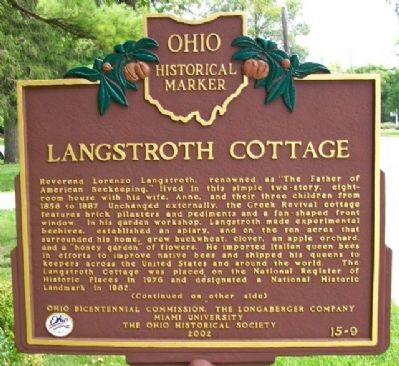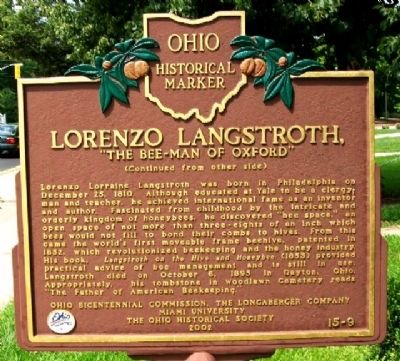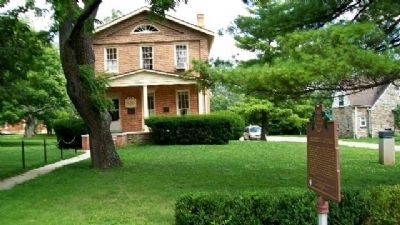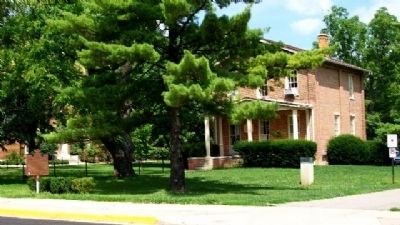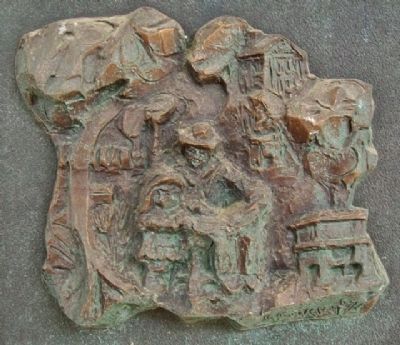Oxford in Butler County, Ohio — The American Midwest (Great Lakes)
Langstroth Cottage / Lorenzo Langstroth
"The Bee-Man of Oxford"
Side A: Langstroth Cottage
Reverend Lorenzo Langstroth, renowned as "The Father of American Beekeeping," lived in this simple two-story, eight-room house with his wife, Anne, and their three children from 1858 to 1887. Unchanged externally, the Greek Revival cottage features brick pilasters and pediments and a fan-shaped front window. In his garden workshop, Langstroth made experimental beehives, established an apiary, and on the ten acres that surrounded his home, grew buckwheat, clover, an apple orchard, and a "honey garden" of flowers. He imported Italian queen bees in efforts to improve native bees and shipped his queens to keepers across the United States and around the world. The Langstroth Cottage was placed on the National Register of Historic Places in 1976 and designated a National Historic Landmark in 1982.
(Continued on other side)
Side B: Lorenzo Langstroth
(Continued from other side)
Lorenzo Lorraine Langstroth was born in Philadelphia on December 25, 1810. Although educated at Yale to be a clergyman and teacher, he achieved international fame as an inventor and author. Fascinated from childhood by the intricate and orderly kingdom of honeybees, he discovered "bee space," an open space of not more than three-eighths of an inch which bees would not fill to bond their combs to hives. From this came the world's first moveable frame beehive, patented in 1852, which revolutionized beekeeping and the honey industry. His book, Langstroth on the Hive and Honeybee (1853) provided practical advice of bee management and is still in use. Langstroth died on October 6, 1895 in Dayton, Ohio. Appropriately, his tombstone in Woodlawn Cemetery reads "The Father of American Beekeeping."
Erected 2002 by Ohio Bicentennial Commission, The Longaberger Company, Miami University, and The Ohio Historical Society. (Marker Number 15-9.)
Topics and series. This historical marker is listed in these topic lists: Agriculture • Education • Horticulture & Forestry • Science & Medicine • Settlements & Settlers. In addition, it is included in the Ohio Historical Society / The Ohio History Connection series list. A significant historical month for this entry is October 1775.
Location. 39° 30.394′ N, 84° 43.832′ W. Marker is in Oxford, Ohio, in Butler County. Marker is on Patterson Avenue (U.S. 27), on the left when traveling south. Marker is about 200 feet south of intersection with Spring Street. Touch for map. Marker is at or near this postal address: 303 S Patterson Avenue, Oxford OH 45056, United States of America. Touch for directions.
Other nearby markers. At least 8 other markers are within walking distance of this marker. The Verlin L. Pulley Tower (about 600 feet away, measured in a direct line); Percy MacKaye / "The Poet's Shack" (approx. 0.2 miles away); Upham Hall (approx. ¼ mile away); William Holmes McGuffey House (approx. 0.3 miles away); Stanton's "Magnificent Dwelling" / Elizabeth Cady Stanton (approx. 0.3 miles away); The Act of 1794 (approx. 0.4 miles away); Alumnae Hall (approx. 0.4 miles away); Freedom Summer 1964 (approx. 0.4 miles away). Touch for a list and map of all markers in Oxford.
Also see . . .
1. Lorenzo Langstroth. (Submitted on November 2, 2009, by William Fischer, Jr. of Scranton, Pennsylvania.)
2. Langstroth on the hive and the honey-bee: a bee keeper's manual. (Submitted on November 2, 2009, by William Fischer, Jr. of Scranton, Pennsylvania.)
3. Langstroth on the Hive and the Honey-Bee: A Bee Keeper's Manual. Audio version of the book on the LibriVox website. (Submitted on October 2, 2019, by Joel Seewald of Madison Heights, Michigan.)
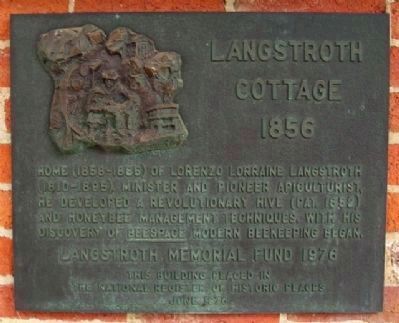
Photographed By William Fischer, Jr., August 3, 2009
3. Langstroth Cottage 1856 Marker
(1810-1895). Minister and pioneer apiculturist,
he developed a revolutionary hive (Pat. 1852)
and honeybee management techniques. With his
discovery of beespace modern beekeeping began.
Langstroth Memorial Fund 1976
This building placed in
the National Register of Historic Places
June 1976
Credits. This page was last revised on November 29, 2019. It was originally submitted on November 2, 2009, by William Fischer, Jr. of Scranton, Pennsylvania. This page has been viewed 2,919 times since then and 33 times this year. Photos: 1, 2, 3, 4, 5, 6. submitted on November 2, 2009, by William Fischer, Jr. of Scranton, Pennsylvania.
